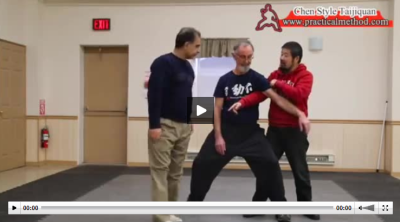Hong Junsheng Taijiquan Philosophy – As I See it
By Zhang Yanhai 张延海 (Translated from http://chenzhonghua.cn)
Mr. Hong Junsheng (1907-1996) of Yu County, Henan Province was an indoor Taijiquan disciple of Mr. Chen Fake for 15 years and as the result has received true transmission of the art. After many years of inheriting the tradition and developing it, Mr. Hong has brought the essence of Taijiquan to a scientific and philosophical level and provided a systematic analysis of the inherent laws of Taijiquan; and at the same time able to demonstrate them visually in front of everyone. He is the first to propose the use of the mechanical concept of “neutral equilibrium” in Taiji. He has his own unique perspective on “rotation” and “silk reeling”.
Mr. Hong devoted his life to the study of Taijiquan and authored a book called “Chen Style Taijiquan Practical Method of Boxing”. Many countries established the Hong Junsheng Taijiquan Research Association. Mr. Hong served in Jinan City, Shandong province Wushu Association as Chairman, United States Chinese martial arts association as Adviser and in United States traditional martial arts association.
I would like to elaborate on my understanding of Mr. Hong’s Taijiquan philosophy in brief.
Firstly – the scientific analysis of Taijiquan. Mr. Hong has ingeniously introduced the study of biomechanics into the practice and understanding of Chen Style Taijiquan making it easy to understand. He uses trajectory motion, linear velocity, angular velocity, orbital motion, rotation, dynamic equilibrium and direct observation to analyze grappling power and silk reeling force.
Secondly – on orbital revolution and rotation. Based on sports biomechanics, he introduced the concept of revolution and rotation on hand techniques – positive and negative revolution and clockwise and anti-clockwise rotation – which he gave specific and detailed explanation. He made it easy to understand the structure and principles of Taijiquan through simple explanations of orbital revolution and rotation. Furthermore he introduced the new concepts of positive and negative spirals to the more general concept of internal and external spirals, making the Taijiquan movements more refined. In Chen Taijiquan’s each movement and posture, the body will revolve on multiple axis of rotation. He is the first to put forward “hand out not elbow out, elbow in not hand in” technique. The circle need not be large, the force depends the turning speed. If your angular velocity is faster than others, nobody can get close to you. This is precisely why practicing with Mr. Hong is a totally different experience.
Thirdly – neutral equilibrium. “Waist as axle” and “Stand poised as a Balance Scale”. These are characteristics of Chen Taijiquan. Mr Hong was the first to introduce neutral equilibrium as a requirement for Chen Taijiquan. The footwork should not change, the body should revolve around a central axis (head erect from baihui point to coccyx as axis) to perform a rotation; and by preventing the shifting of this axis either by your own movement or opponent’s movement, will you preserve your stability. In paired practice, you can hide your center and maintain balance while seeking and destroying your opponent’s center. This is based on human physiology, sports biomechanics, mechanical levers and so on; and it is all summarized in Taijiquan’s dynamic equilibrium principle.
(Original text: http://chenzhonghua.cn/2013/01/%E6%B4%AA%E5%9D%87%E7%94%9F%E5%A4%AA%E6%9E%81%E5%93%B2%E5%AD%A6%E4%B9%8B%E6%88%91%E8%A7%81/)
Apologies for any errors and omissions.


